Flower gardening can be a much-loved passion, but it can also be overwhelming, especially when you’re first starting out. In this ultimate guide, I will share my top flower planting tips for beginners so that you can grow like a pro.
Key Takeaways:
- Start small and don’t be afraid to make mistakes. Flower gardening is a learning process, and you can always adjust and improve your garden over time.
- Focus on good soil and the right location. Test your soil and adjust the mixture accordingly. Choose a spot with ample sunlight and consider container gardening if space is limited.
- Choose the right plants for your garden, including annuals, biennials, and perennials. Embrace the beauty and versatility of annual flowers and self-sowing annuals. Explore the unique characteristics of biennial flowers and the long-lasting appeal of perennial plants.
- Don’t be intimidated by growing roses. Choose rose varieties that thrive in your area, learn how to prune them, and properly prepare them for winter.
- Discover the ease and versatility of growing ornamental grasses. They are low maintenance and can add texture and contrast to your flower garden, extending the beauty into fall and winter.
- Incorporate trees, shrubs, and vines into your flower garden for structure and visual interest. They can also attract birds and butterflies, enhancing the ecosystem.
- Choose plants that are well-suited to the conditions of your garden, considering sunlight requirements, soil preferences, and watering needs. Select compatible plants that will thrive together.
- Prepare the garden bed before planting by adding organic matter, loosening the soil, and planting at the right depth. Consider adding compost or topsoil each year for added nutrients.
- Mulch the garden bed after planting to control weeds, retain moisture, and prevent soil-borne diseases. Use organic mulch materials for best results.
- Maintain your flower garden with essential tasks such as establishing a watering schedule, deadheading flowers, dividing perennials, cutting back plants, and providing seasonal care.
Start with Good Soil and the Right Location
When first starting your flower garden, it’s essential to focus on creating good soil and choosing the right location. By conducting a soil test and adjusting the soil mixture accordingly, you can lay a solid foundation for your flower garden’s growth. Additionally, selecting a spot that receives ample sunlight and considering container gardening if space is limited will ensure optimal conditions for your plants.
Conduct a Soil Test
Before you begin planting, it’s important to understand the composition of your soil. A soil test will provide valuable information about the pH level, nutrient content, and overall health of your soil. You can purchase a soil test kit from your local garden center or send a sample to a laboratory for more detailed analysis. Once you have the results, you can make any necessary adjustments to improve the quality of your soil.
Adjust the Soil Mixture
Based on the results of your soil test, you may need to amend your soil mixture to create the ideal growing conditions for your flowers. If your soil is too acidic, you can add lime to raise the pH level. If it’s too alkaline, sulfur or peat moss can be added to lower the pH. It’s also beneficial to incorporate organic matter such as compost or well-rotted manure into the soil to improve its structure and fertility.
Choose the Right Location
When selecting the location for your flower garden, consider the amount of sunlight it will receive. Most flowers thrive in full to partial sun, so choose a spot that gets at least 6 hours of direct sunlight a day. Avoid areas that are shaded by trees or buildings, as this can inhibit the growth and blooming of your flowers.
If you have limited space or live in an apartment or condo, container gardening is a great option. You can use pots or planters to create a flower garden on a patio, balcony, or even a windowsill. Just make sure the containers have drainage holes to prevent waterlogged soil.
By starting with good soil and choosing the right location, you’ll be setting the stage for a successful flower garden. Remember to conduct a soil test, adjust the soil mixture as needed, and select a location that receives ample sunlight. Whether you’re planting in the ground or in containers, these steps will help provide the optimal conditions for your flowers to thrive.
Choosing the Right Plants: Annuals, Biennials, and Perennials
Many of the most beautiful flowers in a garden are annuals, which need to be planted every year for their vibrant colors. However, some annuals are self-sowing and can produce beautiful plants year after year. On the other hand, biennial flowers have a two-year life cycle and perennials come back year after year, making them a mainstay in any flower garden.
When choosing the right plants for your garden, it’s important to consider the different types available and their unique characteristics. Annual flowers provide an explosion of color and are perfect for adding instant beauty to your garden. Pansies, petunias, impatiens, and marigolds are popular annuals known for their brilliant hues. These plants need to be replanted each year, but their stunning blooms are well worth the effort.
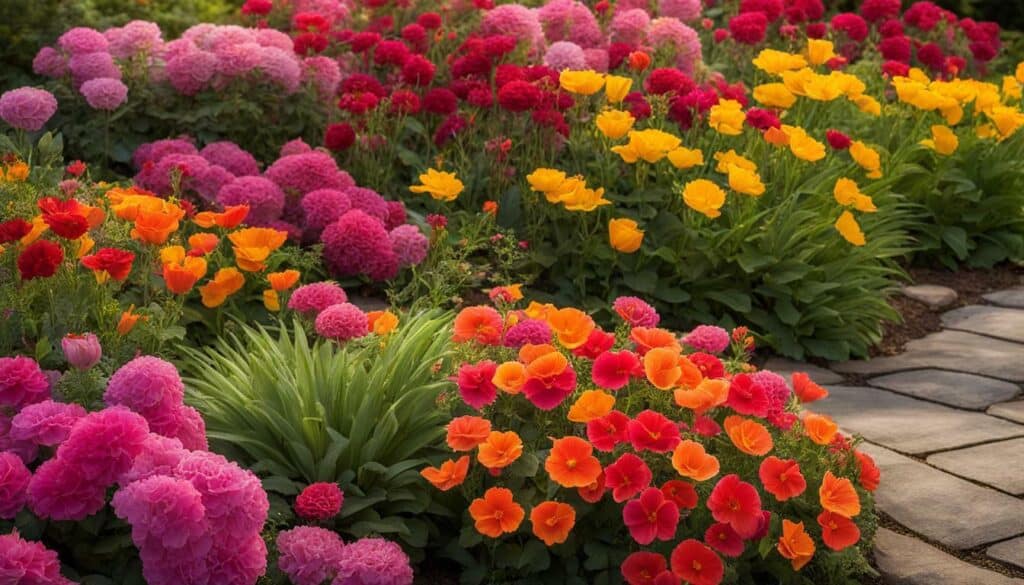
Self-sowing annuals, also known as “volunteer” plants, are a great option for beginners. These flowers have the ability to seed themselves, allowing them to come back year after year without much effort on your part. They can create a beautiful naturalized look in your garden. Some examples of self-sowing annuals include bachelor’s buttons, cosmos, and poppies.
Biennial flowers have a unique two-year life cycle. In the first year, these plants focus on leaf and food production, while in the second year, they produce flowers and seeds before completing their life cycle. Foxgloves and black-eyed Susans are popular biennial flowers known for their stunning blooms. These plants can add height and visual interest to your garden.
Perennial plants are the backbone of any flower garden. They come back year after year, often becoming more beautiful with age. Perennials offer a wide range of colors, shapes, and sizes, making it easy to find plants that suit your personal preferences. Some popular perennial flowers include phlox, daisies, daylilies, and coreopsis. These plants require minimal care and can provide long-lasting beauty.
When choosing the right plants for your flower garden, it’s important to consider your climate, soil conditions, and sun exposure. Different plants have different requirements, so it’s essential to choose varieties that will thrive in your specific garden conditions. Researching and selecting plants that are well-suited to your climate and soil preferences will increase your chances of success.
Additionally, consider the overall aesthetic you want to achieve in your garden. Think about color schemes, plant heights, and the desired bloom time of each plant. By choosing a combination of annuals, self-sowing annuals, biennials, and perennials, you can create a diverse and visually appealing flower garden that provides beauty throughout the seasons.
Growing Roses: Not as Difficult as You Think
Roses often have a reputation for being difficult to grow, but the reality is that most rose bushes will thrive in almost any garden environment. By choosing varieties that are well-suited to your area, knowing how and when to prune your roses, and properly preparing them for winter, you can enjoy beautiful and bountiful blooms in your flower garden.
When selecting rose varieties, it’s important to choose ones that will flourish in your specific climate and growing conditions. Consider factors such as sunlight requirements, soil preferences, and disease resistance. Consulting with local nurseries or gardening experts can provide valuable insights into the best rose varieties for your area.
Pruning is a vital aspect of rose care and can help promote healthy growth and abundant blooms. Prune your roses in late winter or early spring before new growth appears. Remove any dead or damaged wood, as well as any crossing branches that could create congestion. Proper pruning techniques will vary depending on the type of rose, so it’s important to research and follow specific guidelines for each variety.
Preparing roses for winter is crucial to ensure their survival and optimal performance in the following growing season. In late fall, after the first frost, remove any fallen leaves or debris from around the base of the rose bush. This will help prevent the spread of diseases and pests. Cut back the length of the canes to prevent damage from winter winds and snow. Consider adding a layer of mulch around the base of the plant to provide insulation and protect the roots from freezing temperatures.
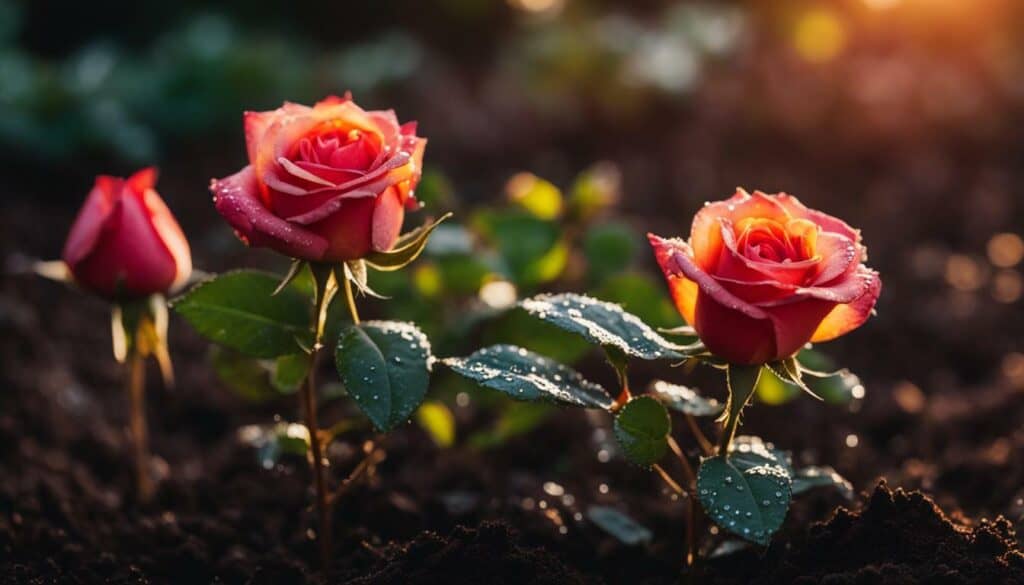
Growing roses can be a rewarding and enjoyable experience, even for beginners. By selecting the right varieties, practicing proper pruning techniques, and preparing them for winter, you can have a stunning rose garden that adds beauty and fragrance to your outdoor space.
Ornamental Grasses: Easy and Versatile
Ornamental grasses have become a staple in backyard gardens, thanks to their ease of growth and versatile nature. These low maintenance plants add texture and contrast to flower gardens and can even extend the beauty of the garden season into the fall and winter months.
“It’s hard to remember a time when ornamental grasses weren’t a fixture in every backyard garden. Even if you can’t tell the various types apart, you can still appreciate the necessary texture, contrast, and visual interest they bring to a garden. The best news: No plant could be easier to grow. Many ornamental types of grass need little-to-no care beyond a bit of occasional watering, making them a great option for even the most novice growers.
Ornamental grasses can serve multiple purposes in a flower garden. They can act as a backdrop for your flowers, providing a lush and dynamic setting. Their tall and graceful structure adds a vertical element that complements the surrounding plants. Additionally, they can serve as a decorative privacy barrier, creating a natural and visually appealing separation in your backyard.
| Benefits of Ornamental Grasses |
|---|
| Low maintenance |
| Textural interest |
| Contrast to flowers |
| Extended garden season |
One of the greatest advantages of ornamental grasses is their low maintenance nature. Once established, they require minimal care and attention. This makes them perfect for beginners or those with limited time for gardening. Occasional watering is usually sufficient, and they are generally resistant to pests and diseases.
Ornamental grasses also add textural interest to a flower garden. Their unique foliage and seed heads create visual appeal and can elevate the overall design. Whether you prefer feathery plumes, spiky blades, or architectural forms, there is an ornamental grass variety to suit your taste.
By incorporating ornamental grasses into your flower garden, you can achieve a beautiful contrast to the flowers. The soft, flowing texture of the grasses complements the bold colors and shapes of the blooms, creating a visually dynamic and harmonious display. It adds depth and dimension to the garden, making it more visually appealing.
Furthermore, ornamental grasses can extend the beauty of the garden season. Many varieties of grasses are at their peak in the fall, when other plants may be fading. Their warm-toned foliage and unique seed heads provide interest and color when other flowers are past their prime. Some grasses even retain their visual appeal throughout the winter, adding structure and beauty to the garden during the colder months.

Whether you have a large garden or limited space, ornamental grasses can be a valuable addition to your flower garden. Their easy growth and versatile nature make them a great choice for beginners and experienced gardeners alike. So, consider incorporating ornamental grasses into your garden design and enjoy the beauty they bring all year round.
Incorporating Trees, Shrubs, and Vines for Structure and Interest
A flower garden is not complete without the inclusion of trees, shrubs, and vines, which provide structure and visual interest. These elements not only add architectural beauty to the garden but also attract birds and butterflies, creating a vibrant and diverse ecosystem.
Trees are the tallest plants in the garden and can serve as focal points or provide shade. Choose trees that are suited to your climate and garden size. Consider flowering trees such as dogwoods or magnolias for added beauty and visual impact. Planting a mix of evergreen and deciduous trees will ensure year-round interest in the garden.
| Types of Trees | Description |
|---|---|
| Evergreen Trees | Retain their foliage year-round, providing color and structure even in the winter months. Some popular options include pine, cedar, and spruce trees. |
| Deciduous Trees | Shed their leaves in the fall, but often offer beautiful foliage color before doing so. Maple, oak, and birch trees are common examples of deciduous trees. |
Shrubs are smaller than trees and can be used to create hedges, borders, or fill in gaps between larger plants. Choose shrubs that have interesting foliage, vibrant flowers, or both. Some popular shrubs for flower gardens include hydrangeas, azaleas, and butterfly bushes. These plants not only provide structure but also attract pollinators to your garden.
- Hydrangeas: Known for their large, showy blooms, hydrangeas come in various colors and can add a pop of color to any garden.
- Azaleas: These flowering shrubs offer vibrant blooms in the spring and are available in a wide range of colors.
- Butterfly Bushes: As the name suggests, butterfly bushes attract butterflies with their fragrant flowers. They come in different colors and can reach heights of up to 6 feet.
Vines are climbing plants that can add vertical interest and create a stunning display when trained to grow on trellises, arches, or pergolas. They can also be used to cover unsightly walls or fences. Choose vines that are suited to your climate and have attractive flowers or foliage. Some popular vines for flower gardens include clematis, morning glories, and climbing roses.
Quote: “Vines can add a sense of romance and whimsy to a flower garden. Their trailing foliage and beautiful flowers can create a magical atmosphere.” – Gardening expert
When selecting trees, shrubs, and vines for your flower garden, consider their growth habits and maintenance requirements. Make sure they are compatible with the other plants in your garden and provide the right amount of sunlight and water. By incorporating these elements into your garden, you can create a harmonious and visually appealing space.
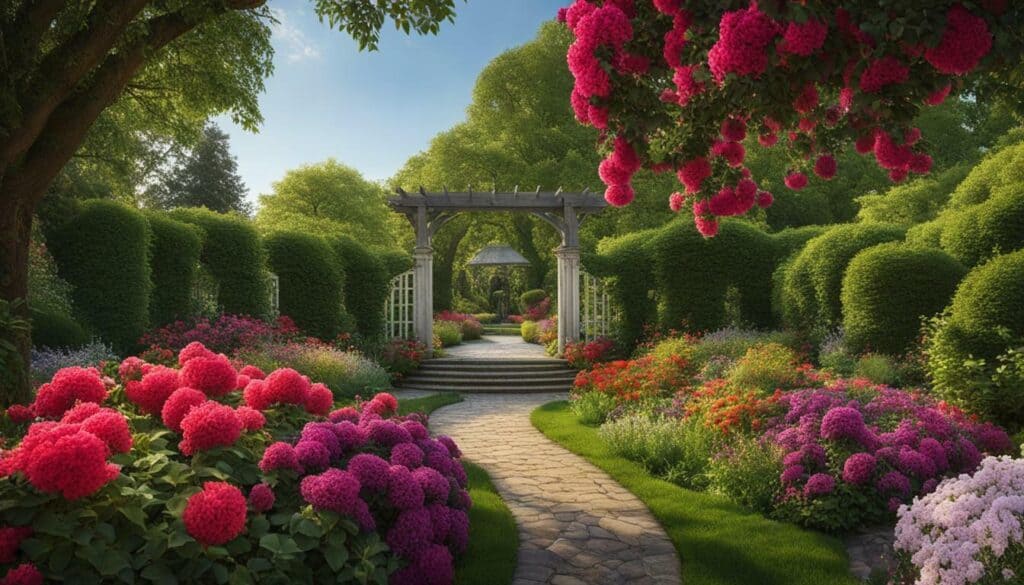
In Summary
Incorporating trees, shrubs, and vines in your flower garden adds structure, visual interest, and attracts birds and butterflies. Trees provide shade and focal points, while shrubs fill in gaps and attract pollinators. Vines add vertical interest and can cover unsightly structures. Choose plants that are suited to your climate and garden size, and ensure they are compatible with the other plants in your garden. With the right selection and placement, your flower garden will be a beautiful and thriving oasis.
Choosing the Right Plants for Your Garden’s Conditions
Selecting the right plants for your flower garden’s conditions is crucial to their success and overall health. By considering their sunlight requirements, soil preferences, and watering needs, you can ensure that each plant thrives. Additionally, choosing compatible plants that work well together will create a harmonious and thriving garden.
When it comes to sunlight requirements, some plants thrive in full sun, while others prefer partial sun or shade. Before selecting plants for your garden, assess the amount of sunlight your garden receives throughout the day. Keep a record and determine if it falls under the categories of full sun, partial sun, partial shade, or full shade. This information will help you choose plants that suit your garden’s specific conditions.
Soil preferences also play a significant role in the health and growth of plants. Some plants prefer well-draining soil, while others thrive in moist or even boggy conditions. Knowing the type of soil you have and understanding the specific needs of your chosen plants will ensure that they receive the appropriate conditions to flourish.
Watering needs can vary depending on the plant species. Some plants require regular watering, while others are more drought-tolerant. Consider the climate in your area and the amount of rainfall it receives when selecting plants. This will help you choose plants that can thrive with the natural water availability in your garden, reducing the need for excessive watering.
In addition to sunlight, soil, and water requirements, it’s important to choose plants that are compatible with each other. Some plants have similar needs and can be grown together without any issues, while others may not thrive in close proximity. Consider the growth habits, space requirements, and potential interactions between plants when planning your garden. This will help you create a well-balanced and cohesive garden design.
Selecting the Right Plants for Your Garden’s Conditions
When selecting plants, keep in mind their specific sunlight requirements, soil preferences, and watering needs. Here are a few examples of plants that thrive under different conditions:
| Light Requirement | Plant Examples |
|---|---|
| Full Sun | Marigolds, Sunflowers, Zinnias |
| Partial Sun/Partial Shade | Impatiens, Begonias, Hostas |
| Full Shade | Ferns, Bleeding Hearts, Astilbes |
Consider the soil preferences of the plants you choose:
“Some plants prefer well-draining soil, while others thrive in moist or even boggy conditions. Examples of plants that prefer well-draining soil include Lavender and Rosemary. On the other hand, plants like Canna Lilies and Elephant Ears thrive in moist or boggy soil.”
Watering needs can also vary among plants:
- Plants with High Water Needs: Hydrangeas, Canna Lilies, and Ferns.
- Drought-Tolerant Plants: Succulents, Lavender, and Yarrow.
When choosing compatible plants for your garden, consider their growth habits and potential interactions. For example, tall-growing plants like Hollyhocks can provide a natural trellis for climbing vines like Morning Glories. Additionally, planting flowers with similar water and soil requirements together can make it easier to provide the appropriate care.
By selecting plants that match your garden’s conditions and are compatible with each other, you will create a thriving and visually appealing flower garden. Remember to consider sunlight requirements, soil preferences, watering needs, and compatibility when choosing plants for your garden’s conditions.
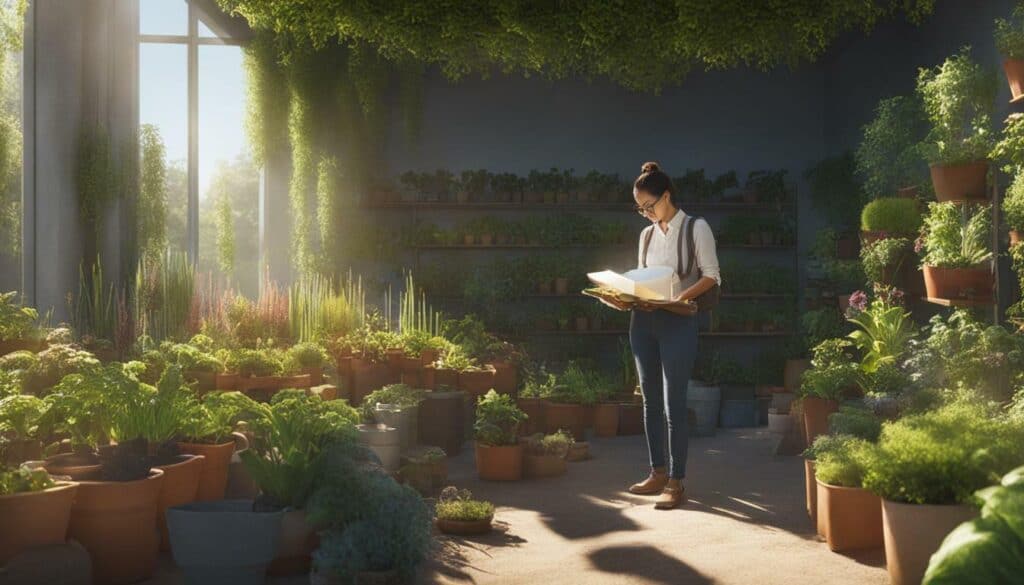
Preparing the Garden Bed for Planting
A well-prepared garden bed is essential for successful flower planting. Before planting flowers, it’s important to add organic matter to the soil, loosen it to the appropriate depth, and ensure that the flowers are planted at the right level. Additionally, adding compost or topsoil to the bed each year will enrich the soil and support healthy plant growth.
To prepare the garden bed, start by removing any weeds or grass from the area. Use a garden spade or a shovel to dig into the soil, loosening it to a depth of at least 12 inches for annuals and 18 inches for perennials. This will provide enough space for the roots to grow and access nutrients.
Once the soil is loosened, incorporate organic matter such as compost or well-rotted manure. This will improve the soil structure, increase fertility, and enhance water retention. Spread a layer of organic matter over the bed and use a garden fork or a tiller to mix it into the soil.
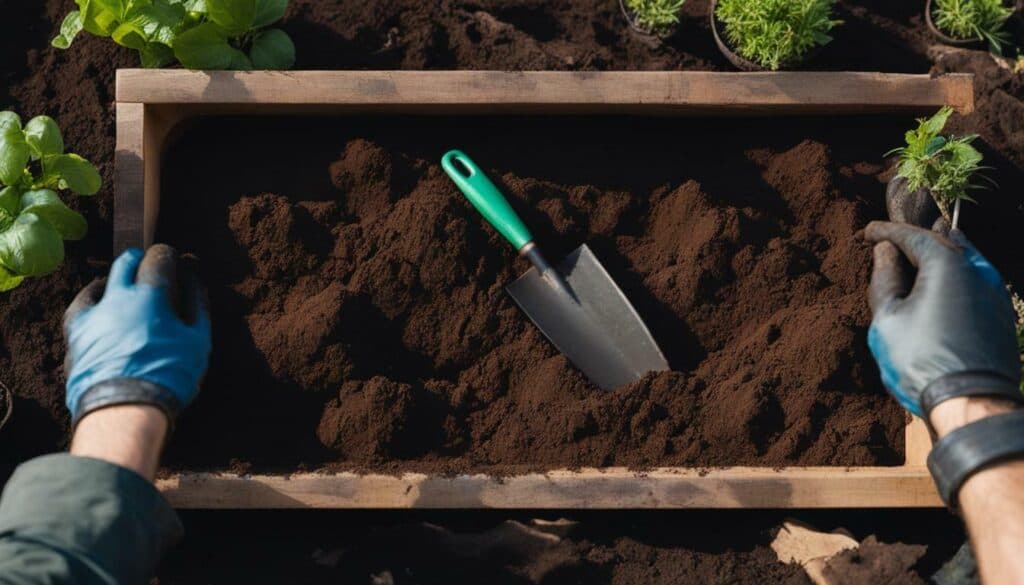
After incorporating the organic matter, smooth the soil surface with a rake, removing any large clumps or debris. This will create a level and even surface for planting.
When planting the flowers, make sure to follow the recommended planting depth for each variety. This information can usually be found on the plant tags or in the planting instructions. Planting too deep or too shallow can affect the growth and development of the flowers.
Once the flowers are planted, consider adding a layer of mulch to the garden bed. Mulch helps suppress weeds, conserve moisture, and regulate soil temperature. Organic mulches such as wood chips, straw, or compost can be applied around the base of the plants.
Benefits of preparing the garden bed:
- Creates a favorable environment for plant growth
- Improves soil structure and fertility
- Enhances water retention
- Provides a level and even surface for planting
- Supports healthy root development
“A well-prepared garden bed is the foundation for successful flower planting. By adding organic matter, loosening the soil, and planting at the right depth, you can provide the optimal conditions for your flowers to thrive.”
Remember to prepare the garden bed before planting flowers to set yourself up for a successful and beautiful flower garden. By taking the time to add organic matter, loosen the soil, and plant at the right depth, you’ll create an environment that promotes healthy growth and abundant blooms.
Mulching for Weed Control and Moisture Conservation
After planting flowers, it’s crucial to mulch the garden bed to control weeds and conserve moisture. Applying a layer of organic mulch, such as wood chips or grass clippings, helps suppress weeds and retain moisture, while also preventing soil-borne diseases that can harm your plants.
Mulching serves as a protective barrier, preventing weed seeds from germinating and competing with your flowers for nutrients and sunlight. The layer of mulch also helps to regulate soil temperature, keeping it cooler in the summer and warmer in the winter, which promotes healthy root growth.
When choosing organic mulch, opt for materials that break down slowly, such as wood chips or shredded bark. These types of mulch not only provide weed suppression and moisture retention, but they also add organic matter to the soil as they decompose, improving soil fertility over time.
Mulching Tips:
- Apply a layer of mulch that is about 2 to 3 inches thick. This provides adequate weed suppression and moisture retention without suffocating your plants.
- Leave a small gap around the base of your flowers to prevent moisture buildup and potential stem rot.
- Avoid piling mulch directly against the plant stems, as this can create a hiding place for pests and promote disease development.
- Consider using an organic mulch that complements the aesthetics of your flower garden. For example, cocoa bean hulls or straw can add a natural and rustic look.
- As the mulch breaks down over time, replenish it annually or as needed to maintain the desired thickness.
“Mulching not only helps control weeds and retain moisture, but it also adds aesthetic value to your flower garden. The layer of mulch creates a clean and polished look, making your flowers stand out even more.”
By mulching your flower garden, you can save yourself time and effort in weed control while ensuring that your flowers have the moisture they need to thrive. The mulch layer acts as a natural barrier, providing a conducive environment for your plants to grow and flourish. So don’t forget to mulch after planting your flowers and enjoy the benefits it brings to your garden.
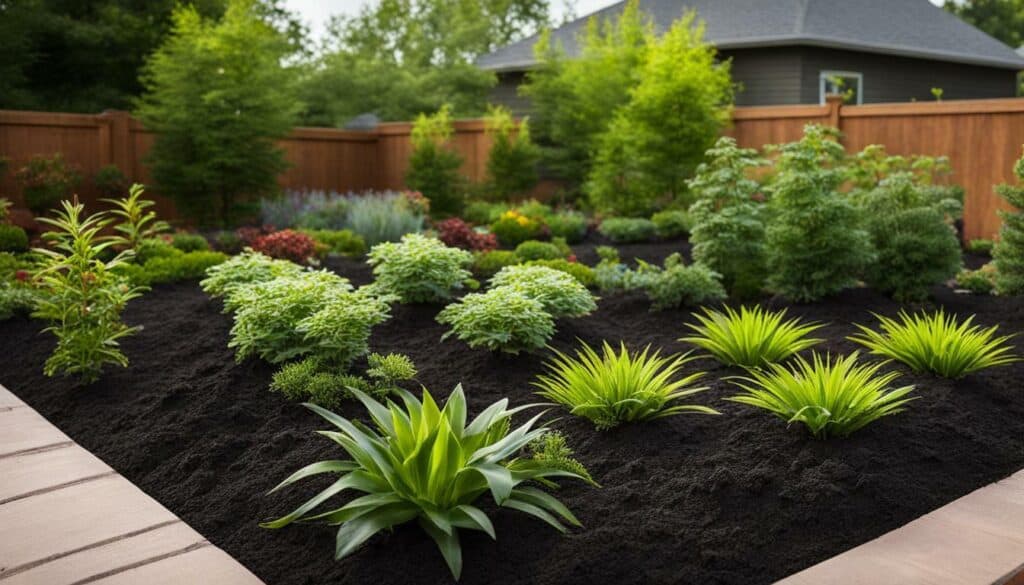
| Benefits of Mulching | Types of Organic Mulch |
|---|---|
|
|
Maintaining a Thriving Flower Garden
Maintaining a thriving flower garden requires regular care and attention. Establishing a watering schedule, deadheading flowers, dividing perennials to promote growth, cutting back plants after their growing season ends, and providing seasonal care are all essential tasks for the success of your flower garden.
Watering Schedule
Watering your flower garden is crucial for healthy plant growth. It’s important to establish a watering schedule to ensure your plants receive the right amount of moisture. Check the soil moisture regularly and water deeply when it becomes dry. Avoid overwatering, as it can lead to root rot and other problems. Use a soaker hose or a drip irrigation system to deliver water directly to the roots, minimizing water waste.
Deadheading
Deadheading is the process of removing spent flower heads from your plants. This helps to redirect the plant’s energy towards new growth and stimulates more blooms. Regular deadheading also improves the overall appearance of your flower garden by keeping it neat and tidy. Use sharp pruning shears or scissors to remove the faded flowers, making sure to cut just above a leaf node or bud.
Dividing Perennials
Dividing perennials is an essential task for promoting healthy growth and preventing overcrowding in your flower garden. Over time, perennials can become overcrowded and less productive. By dividing them, you create more space for the plants to grow and rejuvenate their vigor. Divide perennials in early spring or fall when the weather is cool. Dig up the entire plant, gently separate the root clumps, and replant them in well-prepared soil.
Cutting Back Plants
After the growing season ends, it’s important to cut back certain plants to maintain their health and shape. Prune back any dead, diseased, or damaged stems and branches. Cut back perennial flowers to ground level, leaving only a few inches of stem. Shrubs and trees may require selective pruning to remove excessive growth and maintain their desired form. Always use clean and sharp pruning tools to make clean cuts and prevent the spread of diseases.
Seasonal Care
Each season requires specific care tasks to keep your flower garden thriving. In spring, remove any winter mulch and apply a layer of compost or organic fertilizer to replenish nutrients. In summer, monitor for pests and diseases, and provide additional water during hot and dry periods. In fall, clean up fallen leaves and debris to prevent the spread of diseases. Winter care may involve protecting delicate plants from frost or providing insulation with mulch or burlap.
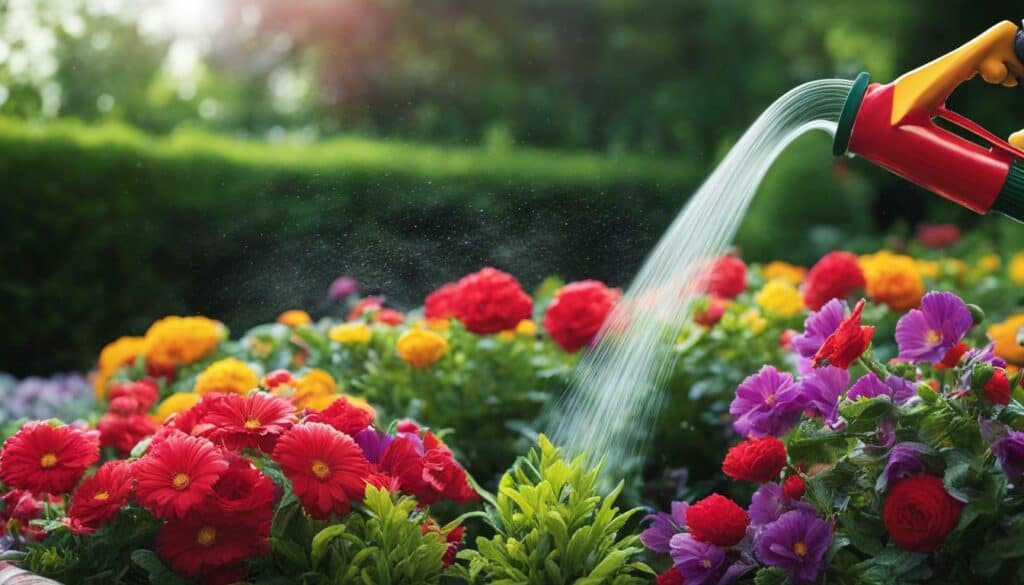
By following these essential maintenance tips, you can ensure that your flower garden stays healthy and vibrant throughout the year. Regular watering, deadheading, dividing perennials, cutting back plants, and providing seasonal care will help your flowers thrive and reward you with a stunning display of color and beauty.
In Conclusion: Cultivate Your Green Thumb and Grow a Beautiful Flower Garden
In conclusion, by following these ultimate flower planting tips for beginners, you can cultivate your green thumb and grow a beautiful flower garden with confidence. Starting small and not being afraid to make mistakes is key to overcoming the overwhelming nature of starting a flower garden.
Start with Good Soil and the Right Location
Creating good soil should be your primary focus when starting your flower garden. Conduct a soil test to determine the pH level and adjust the soil mixture accordingly. Additionally, choose a location that provides ample sunlight for your flowers to thrive.
Choosing the Right Plants: Annuals, Biennials, and Perennials
When selecting plants for your flower garden, consider the different types available. Annual flowers need to be planted every year but can provide brilliant colors. Some annuals are self-sowing, meaning they will seed themselves and produce beautiful plants year after year. Biennial flowers have a two-year life cycle, while perennials come back every year and can make your garden look better with age.
Growing Roses: Not as Difficult as You Think
Contrary to popular belief, growing roses is not as difficult as it seems. Choose rose varieties that will flourish in your area, provide them with plenty of sunlight, and learn the proper techniques for pruning and preparing them for winter.
Ornamental Grasses: Easy and Versatile
Consider incorporating ornamental grasses into your flower garden. They are low-maintenance and can add texture and contrast. Ornamental grasses can also extend the garden season, providing visual interest even in the fall and winter.
Incorporating Trees, Shrubs, and Vines for Structure and Interest
Don’t forget to include trees, shrubs, and vines in your flower garden. They add structure and visual interest, as well as attract birds and butterflies. These elements can enhance the overall ecosystem of your garden.
Choosing the Right Plants for Your Garden’s Conditions
Ensure the success of your flower garden by choosing plants that are well-suited to your garden’s specific conditions. Consider sunlight requirements, soil preferences, and watering needs when selecting plants. Also, choose compatible plants that will thrive together.
Preparing the Garden Bed for Planting
Before planting flowers, it’s important to prepare the garden bed. Add organic matter to the soil, loosen it to the appropriate depth, and plant the flowers at the right level. Consider adding compost or topsoil to the bed each year for added nutrients.
Mulching for Weed Control and Moisture Conservation
After planting flowers, apply mulch to the garden bed. This will help suppress weeds, retain moisture, and prevent soil-borne diseases. Choose organic mulch materials such as wood chips, bark, or grass clippings.
Essential Maintenance Tips for a Thriving Flower Garden
Maintaining your flower garden is crucial for its success. Establish a watering schedule, deadhead flowers to promote continued blooming, divide perennials to produce larger crops, and cut back plants after the growing season. Additionally, provide seasonal care to ensure your garden thrives throughout the year.
By following these tips and incorporating your own creativity and personal touch, you’ll be well on your way to growing a beautiful flower garden that will bring you joy and satisfaction as you watch it flourish and evolve over time.
FAQ
Q: Where should I locate my flower garden?
A: Choose a location with ample sunlight and consider the function of your garden, such as screening an ugly view or adding privacy.
Q: How do I prepare the garden bed for planting?
A: Prepare the soil by adding organic matter, loosening it to the appropriate depth, and planting the flowers at the right level.
Q: What are some low-maintenance plants I can incorporate in my flower garden?
A: Ornamental grasses are a great option for adding texture and contrast to your garden. They require little-to-no care and can extend the garden season.
Q: How do I choose the right plants for my garden’s conditions?
A: Consider the sunlight requirements, soil preferences, and watering needs of plants when selecting them for your garden. It’s also important to choose compatible plants that will thrive together.
Q: What are some essential maintenance tips for a thriving flower garden?
A: Establish a watering schedule, deadhead flowers, divide perennials, cut back plants after the growing season, and provide seasonal care to ensure your flower garden thrives.
What Are Some Beginner-Friendly Tips for Growing a Green Paradise in My Garden?
Looking to transform your garden into a lush green paradise? Here are some top tips for green garden success! Start by choosing easy-to-grow plants like herbs and vegetables. Opt for organic fertilizers and compost to nourish the soil naturally. Proper watering and regular weeding are essential for maintaining a healthy garden. Lastly, don’t forget to mulch to retain moisture and deter weeds.

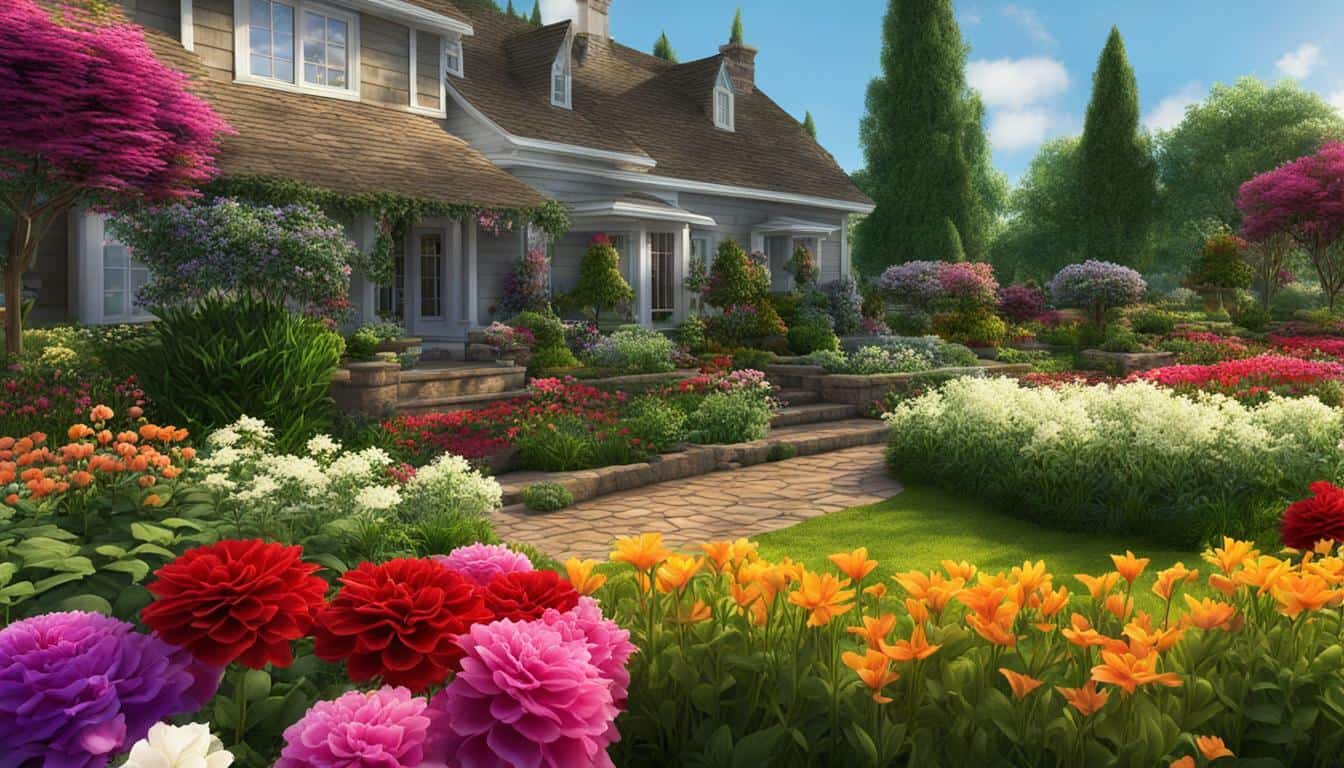



Leave a Reply